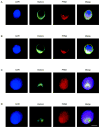Characterization of nucleohistone and nucleoprotamine components in the mature human sperm nucleus
- PMID: 18478156
- PMCID: PMC3856397
- DOI: 10.1111/j.1745-7262.2008.00410.x
Characterization of nucleohistone and nucleoprotamine components in the mature human sperm nucleus
Abstract
Aim: To simultaneously determine the localization of histones and protamines within human sperm nuclei.
Methods: Immunofluorescence of the core histones and protamines and fluorescence in situ hybridization of the telomere region of chromosome 16 was assessed in decondensed human sperm nuclei.
Results: Immunofluorescent localization of histones, protamine 1 (PRM1) and protamine 2 (PRM2) along with fluorescence in situ hybridization localization of chromosome 16 telomeric sequences revealed a discrete distribution in sperm nuclei. Histones localized to the posterior ring region (i.e. the sperm nuclear annulus), whereas PRM1 and PRM2 appeared to be dispersed throughout the entire nucleus.
Conclusion: The co-localization of the human core sperm histones with the telomeric regions of chromosome 16 is consistent with the reorganization of specific non-protamine regions into a less compacted state.
Figures



References
-
- Krawetz SA. Paternal contribution: new insights and future challenges. Nat Rev Genet. 2005;6:633–42. - PubMed
-
- Rousseaux S, Caron C, Govin J, Lestrat C, Faure AK, Khochbin S. Establishment of male-specific epigenetic information. Gene. 2005;345:139–53. - PubMed
-
- Berger SL. Histone modifications in transcriptional regulation. Curr Opin Genet Dev. 2002;12:142–8. - PubMed
-
- Govin J, Caron C, Lestrat C, Rousseaux S, Khochbin S. The role of histones in chromatin remodelling during mammalian spermiogenesis. Eur J Biochem. 2004;271:3459–69. - PubMed
Publication types
MeSH terms
Substances
Grants and funding
LinkOut - more resources
Full Text Sources

